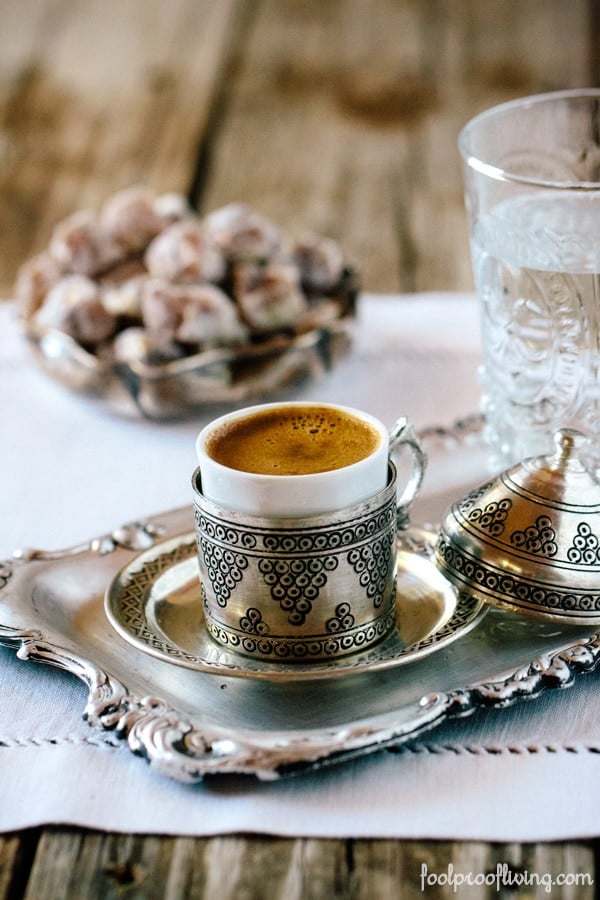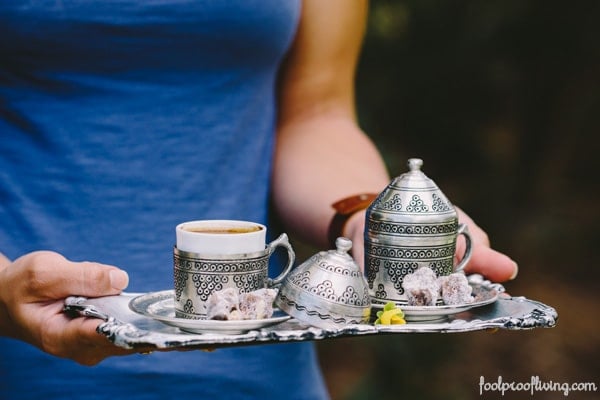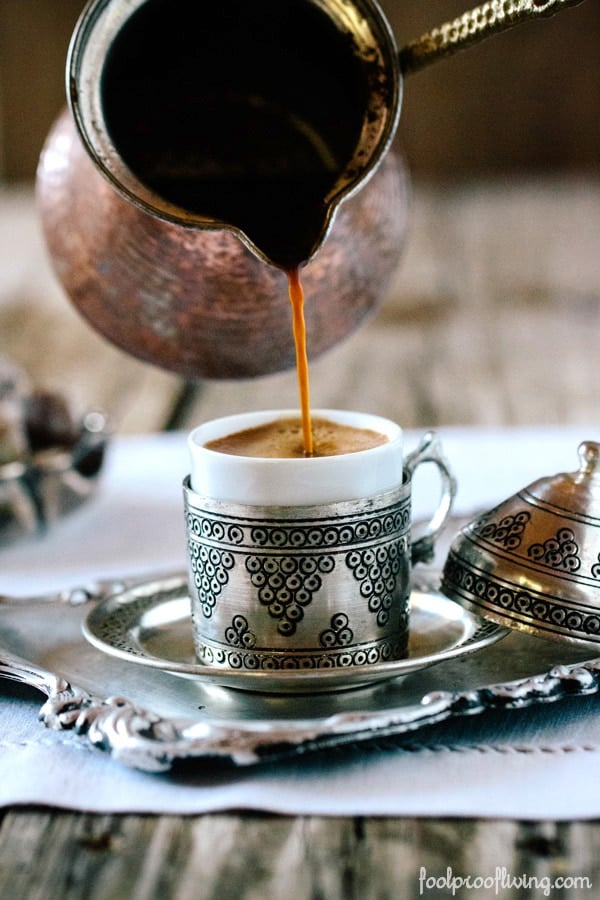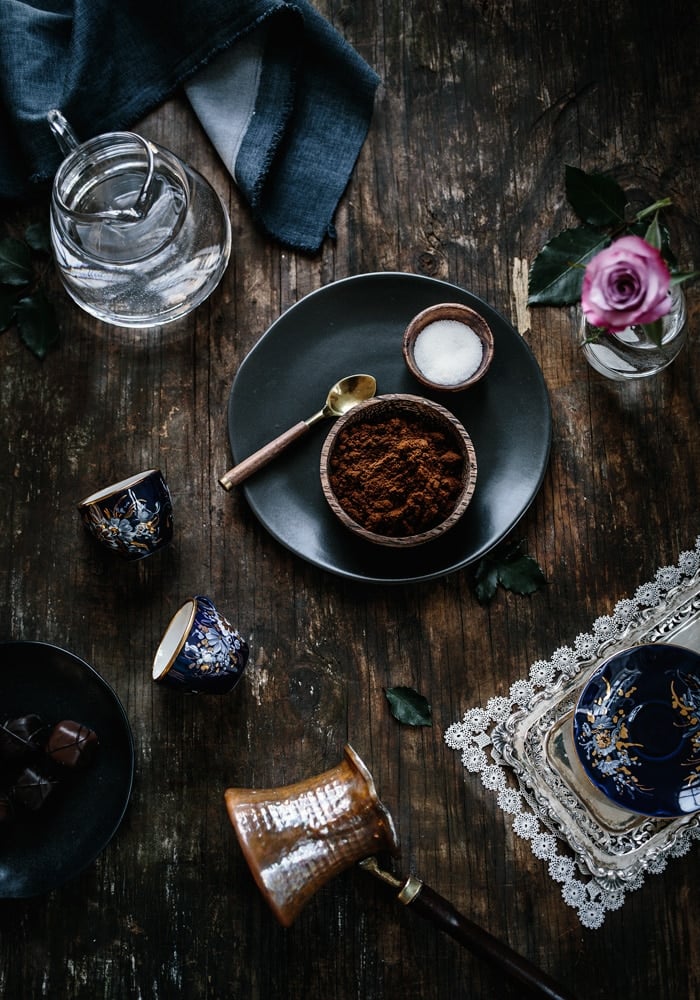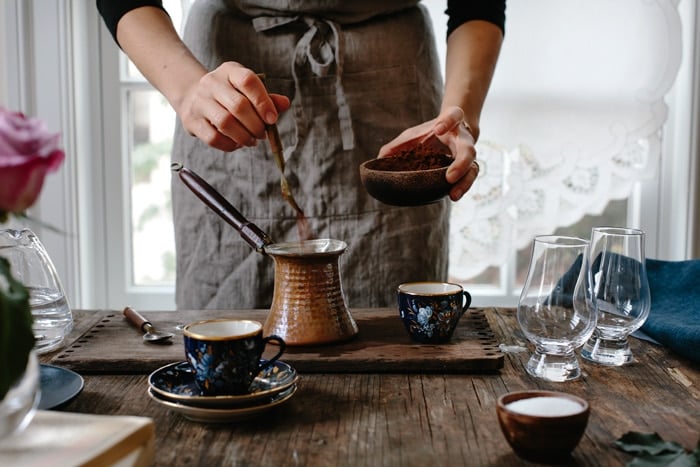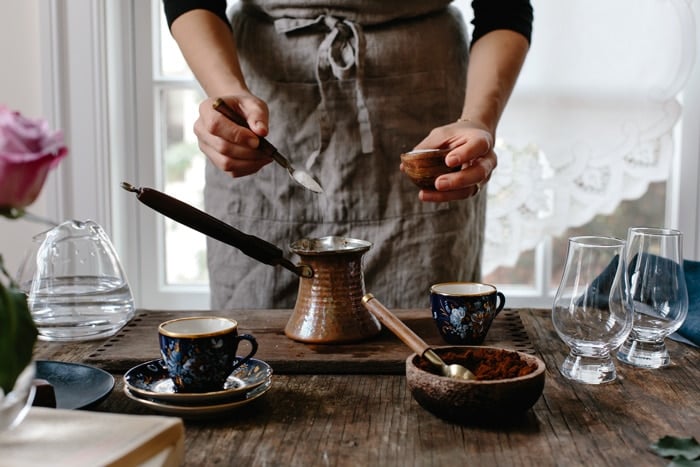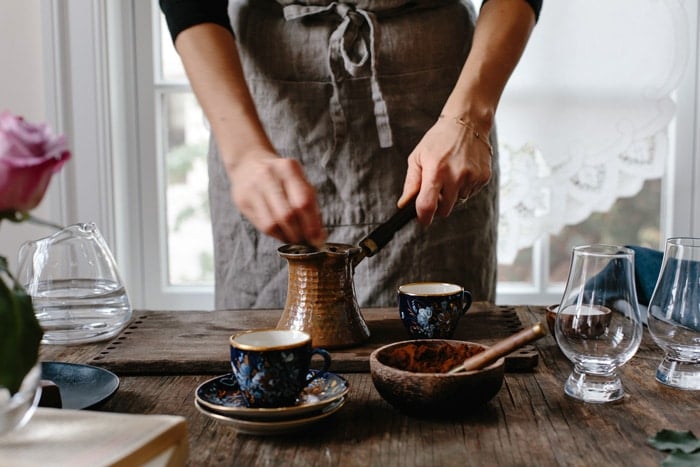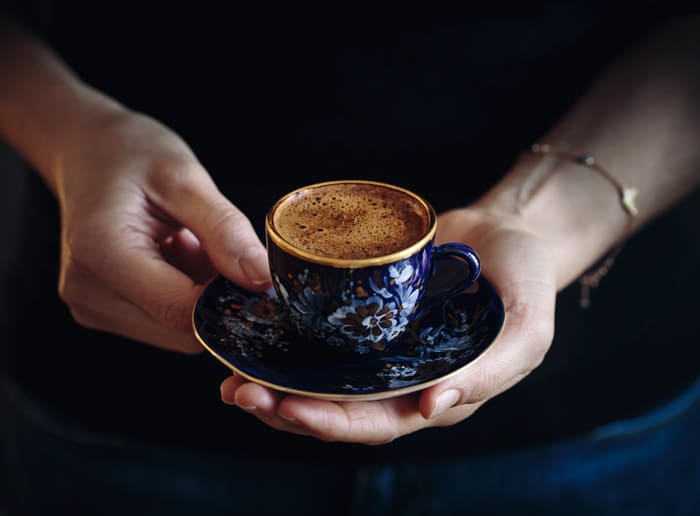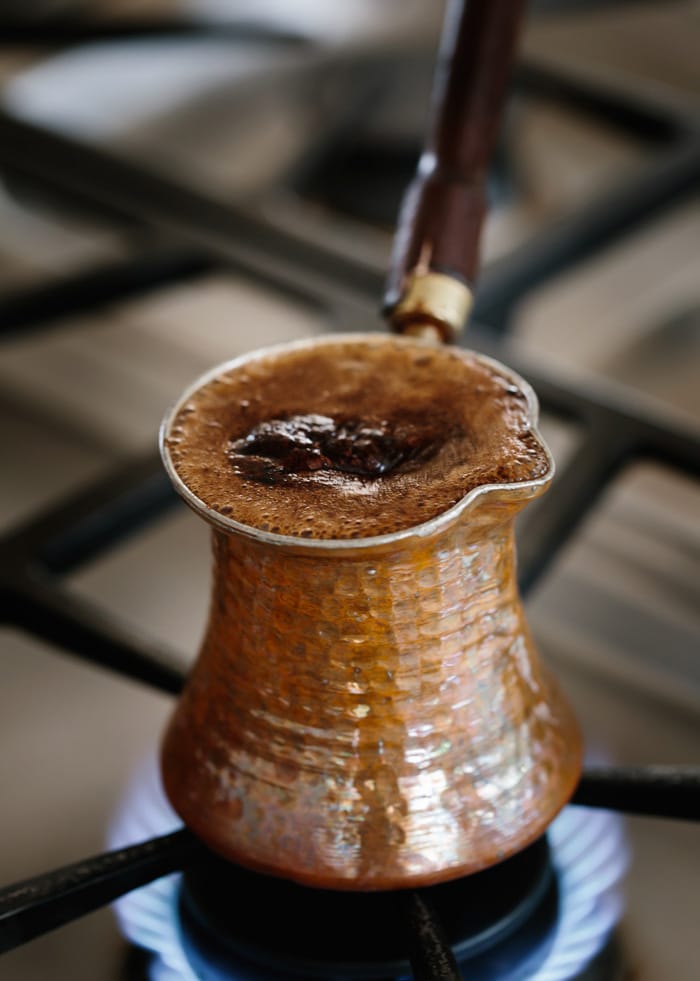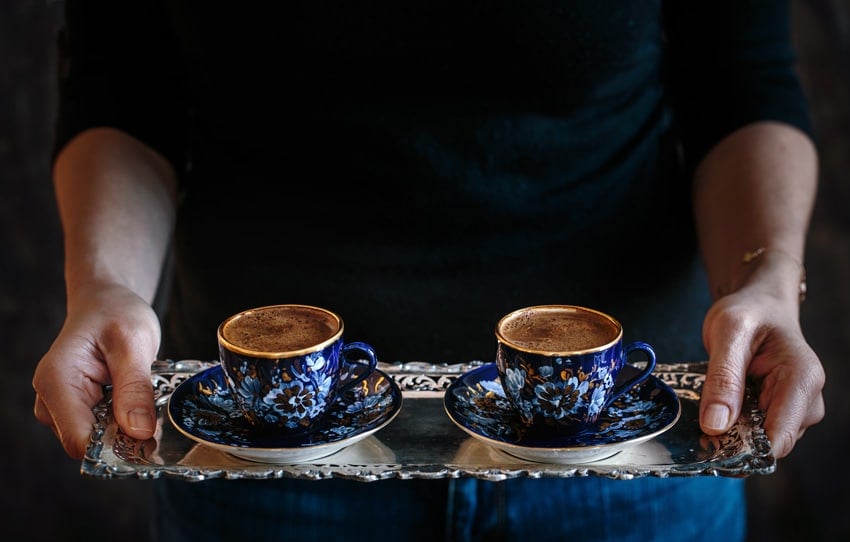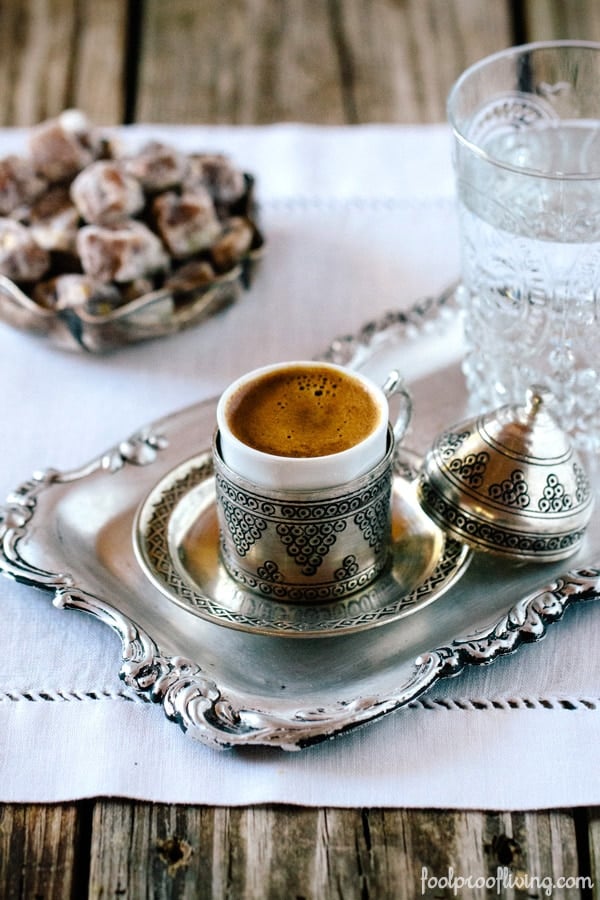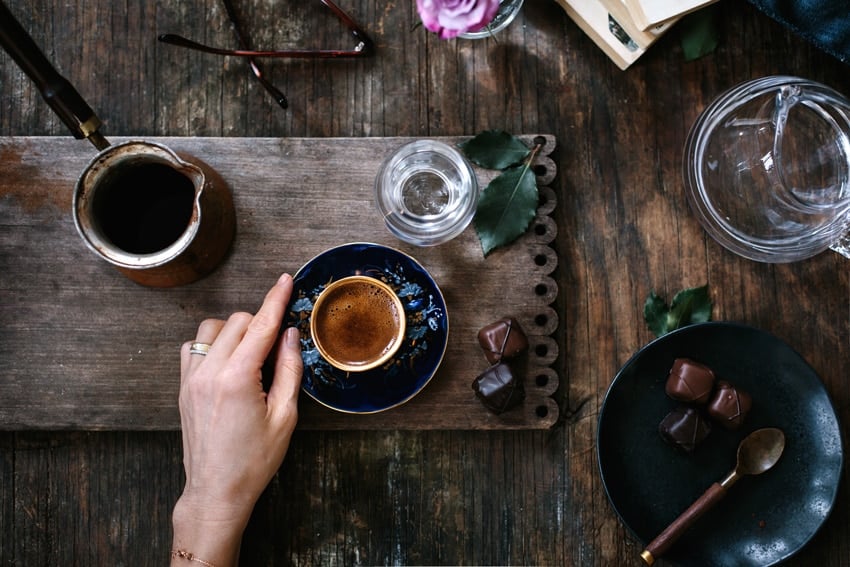For her, having Turkish coffee was almost a daily ritual that had to be done with friends and family. More than anything, it was a way to celebrate her friendships and show gratitude to the ones she loved. Though she worked most of her life, on those rare days when she was home, she would invite her friends over for coffee in the morning. Prior to their arrival, she would make me set up two trays: the first one with Turkish coffee cups and the second one with water glasses. We would always have something sweet to serve the coffee with. Although Turkish delights are more traditional, my mother loved serving hers with chocolate. When her friends would arrive, it was my job to make and serve the coffee. After welcoming them, I would ask how they take their coffee and then immediately go to the kitchen to make it to their liking. It was such a proud moment for my mother when I would come out of the kitchen with the tray in my hand. When I look back and think about it today, I realize how important it was for her that I understood the tradition behind it. I was very fortunate that I was allowed to drink coffee at a young age and learn to enjoy it through the family tradition. In Turkey, when you go to somebody’s house, the first question isn’t if you want to drink Turkish coffee, but rather how you would like to have your coffee prepared. By how, your host is asking about the amount of sugar you would like to have in your coffee. To answer the question, you may say “sade” which means no sugar; “az seker” which means very little sugar; “orta” which means with 1-2 teaspoons of sugar; or “sekerli” which means with 3-4 teaspoon sugar. Once you place your request, it is the responsibility of the person making the coffee to prepare it according to everyone’s individual sugar preferences. Usually, that person is the youngest girl of the house. As you can imagine, as the only daughter of our household, I’ve made more than my fair share of coffee in my lifetime. Therefore, I feel qualified enough to share my knowledge with you.
Ingredients You Need:
You will need:
Cold filtered water Turkish coffee: Turkish coffee is much more finely ground than regular coffee. Even though you can grind it yourself, nowadays you can find it in most Middle Eastern or Mediterranean supermarkets. My favorite brand is Kurukahveci Mehmet Efendi (affiliate link). Cezve (a special wide-bottomed pot, usually made of copper) I have one similar to this Copper Turkish Coffee Pot (affiliate link) and have been using it for years. Turkish coffee cups: Here is a set (affiliate link) you can purchase Granulated sugar
How to Make Turkish Coffee
Making Turkish coffee is easy and requires no special skills, so long as you know a couple of tricks. Here is how in a nutshell:
Water: Always use cold, filtered water. To measure the amount of water for each cup, use the coffee cup you are going to use. When it comes to the water to Turkish coffee proportions my rule of thumb is 1½ “cup” of water per cup. Once again, the “cup” measurement is the coffee cup that you are going to serve the coffee in, rather than a standard measuring cup.
Coffee & Sugar: For each cup of coffee, use a heaping tablespoon of ground coffee. If preparing a cup with sugar, add it in the very beginning, stirring the mixture until combined. However, if one or more of the guests prefer no sugar, prepare and pour that cup first. After returning the coffee pot to the stove, add in more sugar to suit the preferences of the remaining guests.
How To Cook Turkish Coffee
Slowly bring the mixture to a boil over medium heat. This will take 3-4 minutes, so keep a close eye on it. As the coffee warms, a dark foam will build. It is customary and important to serve Turkish coffee with foam on top. When the mixture is close to a boil, use a teaspoon to transfer some of the foam into each coffee cup. Return the coffee pot to the stovetop. As coffee comes to a boil, pour half of the coffee into the cups, over the foam. Return coffee pot to stovetop and boil the remaining coffee for an additional 10-15 seconds and fill the cups to the rim.
How To Serve:
To serve:
We always serve Turkish coffee with cold (or room temperature) water, because a sip of water will allow the person to clear his/her palate before drinking coffee for the best enjoyment. In addition to water, most people like to serve it with a small sweet treat like Turkish delights, chocolate, candy, etc. When serving it is important to start with the eldest guest in the room. It is a sign of respect to acknowledge their age and considered disrespectful not to do so. Since this type of coffee is much denser than filtered coffee, it is not customary to drink more than one cup. I have read on some websites that some people add milk or cream to their coffee, but to be honest, I have never seen anyone in Turkey add milk or cream to their Turkish coffee.
Almost eight years after her passing, when I close my eyes and think about my mother today, I picture her with a Turkish coffee cup in her hand, telling stories of whatever is happening on that particular day. Though I want to continue our family tradition every opportunity I get, I know it will never be the same without her.
Do I need that special pot (cezve or ibrik) to make Turkish coffee?
The answer is, it depends. I recommend getting it as (1) it is a tradition to cook Turkish coffee in a cezve and (2) cooking it in a cezve will give you the thick foam (more in this below) on top. With that being said, if you are not concerned with those two things, you can make our coffee in a very small saucepan.I have one similar to this Copper Turkish Coffee Pot (affiliate link) and have been using it for years.
How do you get that thick foam on top?
This is a much-debated subject and you might get different answers if you asked different people. Below steps were what my mother taught me:
Once you mix water, coffee and sugar (if using), give it a quick mix but do not overmix it. Since you are cooking it in a very small pot (cezve), as it boils it will mix itself. I know that it is very tempting to want to mix it but resist the urge. Once you pour your first pour, then you can give it a mix because the thick foamy part should already be in the cup. As you pour your second, be sure to pour very slowly to not break the foam.
Where did you get the blue cups in the photos?
I borrowed those cups from a friend of mine. They were a gift to her from her husband. He purchased them from Pasabahce many years ago. I am not sure if they are still selling them, but since this was asked more than once I thought I can answer it here. Second, you can start making it with no sugar, pour the first pour to all the cups and then add in the sugar in the second pour. For example: Let’s say I making Turkish coffee for 2 of my guests. First, start with the person who wants his sade (with no sugar) and then continue with the second person who wants his orta (1-2 teaspoon sugar). Below are the steps I would follow to make them at the same time in one pot (cezve):
Start by cooking water and coffee for 2 servings with no added sugar Pour your first pour halfway into two coffee pots. Boil the second pour and fill up the first serving with no sugar. Then add in sugar into the pot, mix it, and bring it to a boil before you top off the second serving. Since Turkish coffee is pretty thick and served in such a small cup, it will have enough sweetness.
Where can I find Turkish Coffee cups?
If you ever visit Turkey and most other nearby countries, you can find a variety of options for Turkish coffee cups. However, if that is not possible you can easily find them online. Additionally, you can use espresso cups. They are a little larger but they would do the job. Here is a set (affiliate link) you can use to make both types of coffees.
What is Turkish Coffee reading (fortune-telling)? Do you believe it?
It is a tradition that after you finish your coffee, you turn your cup upside down and let it cool down so that someone else can “read your cup”. This is a fun tradition, where someone (who is talented enough to make up stuff) looks into the cup and tries to guess your future based on the shapes of the coffee’s residue that stuck on the walls of your cup. If you are a believer of this kind of stuff, it could be quite entertaining. My mom was one of those people, who would read people’s cups just for the fun of it. I no longer believe in such readings, but when I was a teenager and was falling in love with a different guy every week, I remember drinking a lot of Turkish coffee and begging her to read my cup to see if “my new found love” is going to ask me out any time soon. 🙂
